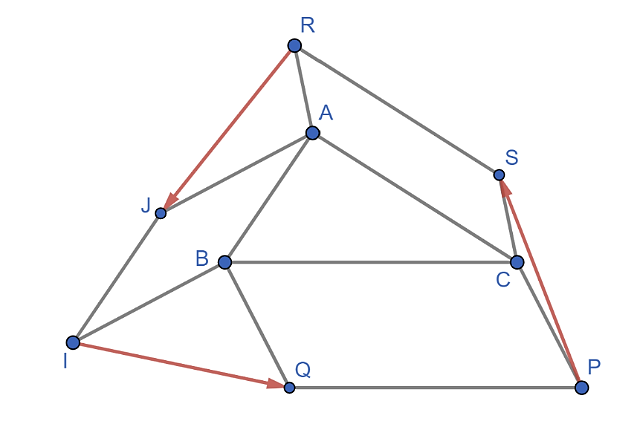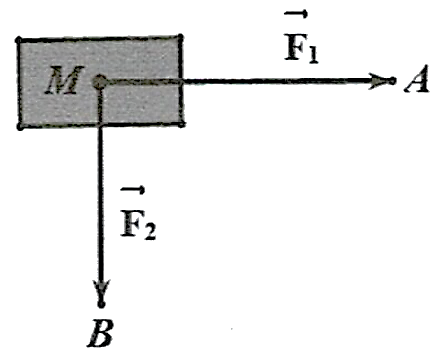Cho hình vuông \(ABCD\) có cạnh bằng \(a\).

a) \(\overrightarrow {BA} - \overrightarrow {CB} = \overrightarrow {BD} \).
b) Độ dài vectơ \(\overrightarrow {AB} + \overrightarrow {AD} \) bằng \(2a\).
c) Gọi \(E\) là điểm đối xứng với \(A\) qua \(B\). Khi đó \(\overrightarrow {DB} + \overrightarrow {DC} = \overrightarrow {DE} \).
d) Độ dài vectơ \(\overrightarrow {DB} + \overrightarrow {DC} \) bằng \(a\sqrt 5 \).
Cho hình vuông \(ABCD\) có cạnh bằng \(a\).

a) \(\overrightarrow {BA} - \overrightarrow {CB} = \overrightarrow {BD} \).
b) Độ dài vectơ \(\overrightarrow {AB} + \overrightarrow {AD} \) bằng \(2a\).
c) Gọi \(E\) là điểm đối xứng với \(A\) qua \(B\). Khi đó \(\overrightarrow {DB} + \overrightarrow {DC} = \overrightarrow {DE} \).
d) Độ dài vectơ \(\overrightarrow {DB} + \overrightarrow {DC} \) bằng \(a\sqrt 5 \).
Quảng cáo
Trả lời:
a) Đúng. Ta có \(\overrightarrow {BA} - \overrightarrow {CB} = \overrightarrow {BA} + \overrightarrow {BC} = \overrightarrow {BD} \).
b) Sai. Ta có \(\left| {\overrightarrow {AB} + \overrightarrow {AD} } \right| = \left| {\overrightarrow {AC} } \right| = AC = a\sqrt 2 \).
c) Đúng.

Ta có \[\left\{ \begin{array}{l}BE = DC\,\left( { = BA} \right)\\BE{\rm{//}}DC\end{array} \right.\]\[ \Rightarrow \]tứ giác \[BECD\] là hình bình hành. Do đó \(\overrightarrow {DB} + \overrightarrow {DC} = \overrightarrow {DE} \).
d) Đúng. Ta có \(\left| {\overrightarrow {DB} + \overrightarrow {DC} } \right| = \left| {\overrightarrow {DE} } \right| = DE = 2DI = 2\sqrt {D{C^2} + C{I^2}} = 2\sqrt {{a^2} + {{\left( {\frac{a}{2}} \right)}^2}} = a\sqrt 5 \) (với I là tâm của hình bình hành \[BECD\]).
Hot: 1000+ Đề thi cuối kì 1 file word cấu trúc mới 2025 Toán, Văn, Anh... lớp 1-12 (chỉ từ 60k). Tải ngay
- Trọng tâm Toán, Văn, Anh 10 cho cả 3 bộ KNTT, CTST, CD VietJack - Sách 2025 ( 13.600₫ )
- Trọng tâm Lí, Hóa, Sinh 10 cho cả 3 bộ KNTT, CTST và CD VietJack - Sách 2025 ( 40.000₫ )
- Sách lớp 10 - Combo Trọng tâm Toán, Văn, Anh và Lí, Hóa, Sinh cho cả 3 bộ KNTT, CD, CTST VietJack ( 75.000₫ )
- Sách lớp 11 - Trọng tâm Toán, Lý, Hóa, Sử, Địa lớp 11 3 bộ sách KNTT, CTST, CD VietJack ( 52.000₫ )
CÂU HỎI HOT CÙNG CHỦ ĐỀ
Lời giải

a) Đúng. Theo quy tắc ba điểm, ta có \(\overrightarrow {RJ} = \overrightarrow {RA} + \overrightarrow {AJ} \).
b) Sai. Ta có \(\overrightarrow {IQ} = \overrightarrow {IB} + \overrightarrow {BQ} \).
c) Sai. Ta có \(\overrightarrow {PS} = \overrightarrow {PC} + \overrightarrow {CS} \).
d) Đúng. Do \(CARS\) là hình bình hành nên \(\overrightarrow {RA} = \overrightarrow {SC} \).
Do \(ABIJ\) là hình bình hành nên \(\overrightarrow {AJ} = - \overrightarrow {IB} \).
Khi đó, \(\overrightarrow {RJ} = \overrightarrow {RA} + \overrightarrow {AJ} = \overrightarrow {SC} - \overrightarrow {IB} \).
Do \(BCPQ\) là hình bình hành nên \(\overrightarrow {BQ} = \overrightarrow {CP} \).
Khi đó, \(\overrightarrow {IQ} = \overrightarrow {IB} + \overrightarrow {BQ} = \overrightarrow {IB} + \overrightarrow {CP} \).
Vậy ta có \(\overrightarrow {RJ} + \overrightarrow {IQ} + \overrightarrow {PS} \)\[ = \left( {\overrightarrow {SC} - \overrightarrow {IB} } \right) + \left( {\overrightarrow {IB} + \overrightarrow {CP} } \right) + \left( {\overrightarrow {PC} + \overrightarrow {CS} } \right)\]\(\)
\( = \left( {\overrightarrow {SC} + \overrightarrow {CS} } \right) + \left( {\overrightarrow {IB} - \overrightarrow {IB} } \right) + \left( {\overrightarrow {CP} + \overrightarrow {PC} } \right) = \overrightarrow 0 \).
Vậy \(\overrightarrow {RJ} + \overrightarrow {IQ} + \overrightarrow {PS} = \vec 0\).
Câu 2
Lời giải
Đáp án đúng là: A
Ta có \[\overrightarrow {AB} + \overrightarrow {CD} + \overrightarrow {BC} + \overrightarrow {DA} = \left( {\overrightarrow {AB} + \overrightarrow {BC} } \right) + \left( {\overrightarrow {CD} + \overrightarrow {DA} } \right) = \overrightarrow {AC} + \overrightarrow {CA} = \overrightarrow {AA} = \overrightarrow 0 \].
Lời giải
Bạn cần đăng ký gói VIP ( giá chỉ từ 199K ) để làm bài, xem đáp án và lời giải chi tiết không giới hạn.
Câu 4
Lời giải
Bạn cần đăng ký gói VIP ( giá chỉ từ 199K ) để làm bài, xem đáp án và lời giải chi tiết không giới hạn.
Câu 5
Lời giải
Bạn cần đăng ký gói VIP ( giá chỉ từ 199K ) để làm bài, xem đáp án và lời giải chi tiết không giới hạn.
Lời giải
Bạn cần đăng ký gói VIP ( giá chỉ từ 199K ) để làm bài, xem đáp án và lời giải chi tiết không giới hạn.
Câu 7
Lời giải
Bạn cần đăng ký gói VIP ( giá chỉ từ 199K ) để làm bài, xem đáp án và lời giải chi tiết không giới hạn.
